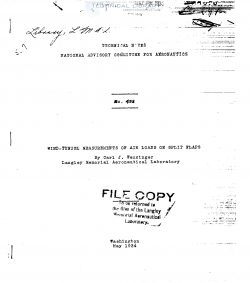naca-tn-498
- Version
- 114 Downloads
- 564.90 KB File Size
- 1 File Count
- November 25, 2016 Create Date
- November 25, 2016 Last Updated
National Advisory Committee for Aeronautics, Technical Notes - Wind Tunnel Measurements of Air Loads on Split Flaps

Tests were made in the N.A.C.A. 7 by 10 foot wind
tunnel to determine the centrol forces and air loads act—
ing on split flaps. Clark Y wing models were used with
two different sizes of full—span split flaps; one having
a medium chord (0. 25c) and the other a narrow chord (0.15c).
Hinge moments of the flaps were measured and also the divi-
sion of load between the flaps and the wing.
The investigation showed that, at the angles of attack .
and flap deflections-for maximum lift, the lift loads on ’
the split flaps were only 5 percent and 9 percent of the“
total lift for-the narrow and mediumrchord flaps respective—
ly. The ratio of drag on the flaps to total drag increased
greatly with decreasing angle of attack, reaching a value
of approximately unity at small negative angles of attack
with the flaps fully deflected.
The normal force on the split flaps increases both
with angle of attack and with flap deflection for angles
of attack below the stall. The value of the normal—force
coefficient is about 1.40 at the angle of_ attack and f_lap
deflection for maximum lift with either of the flaps test~
ed. The center of pressure of the load on the split flaps
in general moves forward with decreasing flap deflection
and with increasing angle of attack from small negative
angles up to the stall.
The hinge moments of the narrow—chord split flap were
about 42 percent those of the medium—chord flap wh_en de—
flected to give approximately the same maximum lift', but
they are considered to be still too large for rapid and
easy flap operation.
Split trailing-edge flaps...ers assuming atil..izec_1_ to a
considerable extent on airplanes for reducing the landing
speed and for increasing the range of gliding angles. The
use of these flaps has given rise to sereral new problems,
particularly those involving control forces and methods of
construction and operation. Some of the aerodynamic char-
acteristics of wings equipped with split flaps have_already
been investigated and considerable data are available on
the lift, drag, and center of pressure_of these combinations.
(See.references l, 2, and 3.) Very little data, however,
have been available to designers concerning the character-
istics of split flaps alone.
| File | Action |
|---|---|
| naca-tn-498 Wind Tunnel Measurements of Air Loads on Split Flaps.pdf | Download |

Comment On This Post